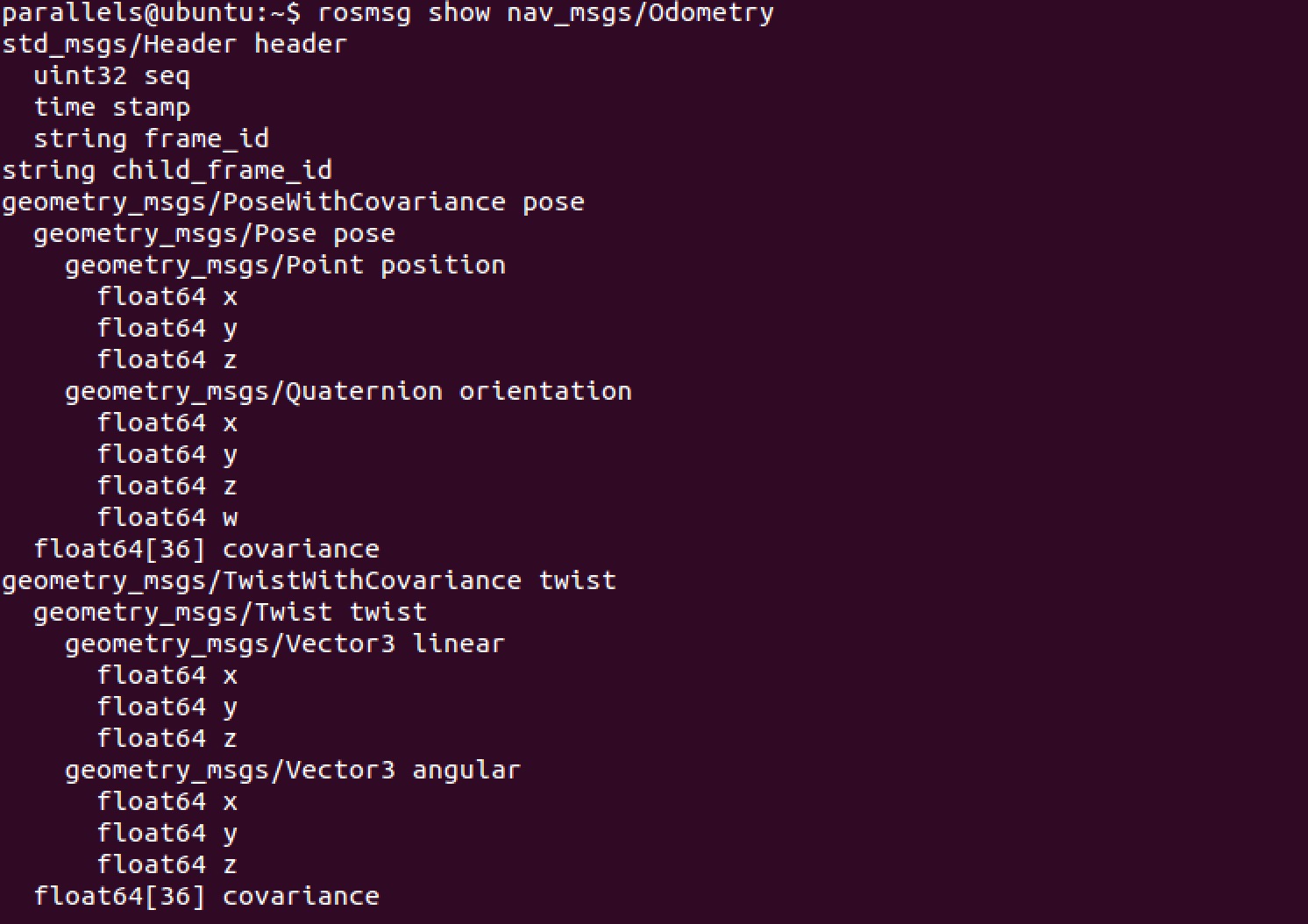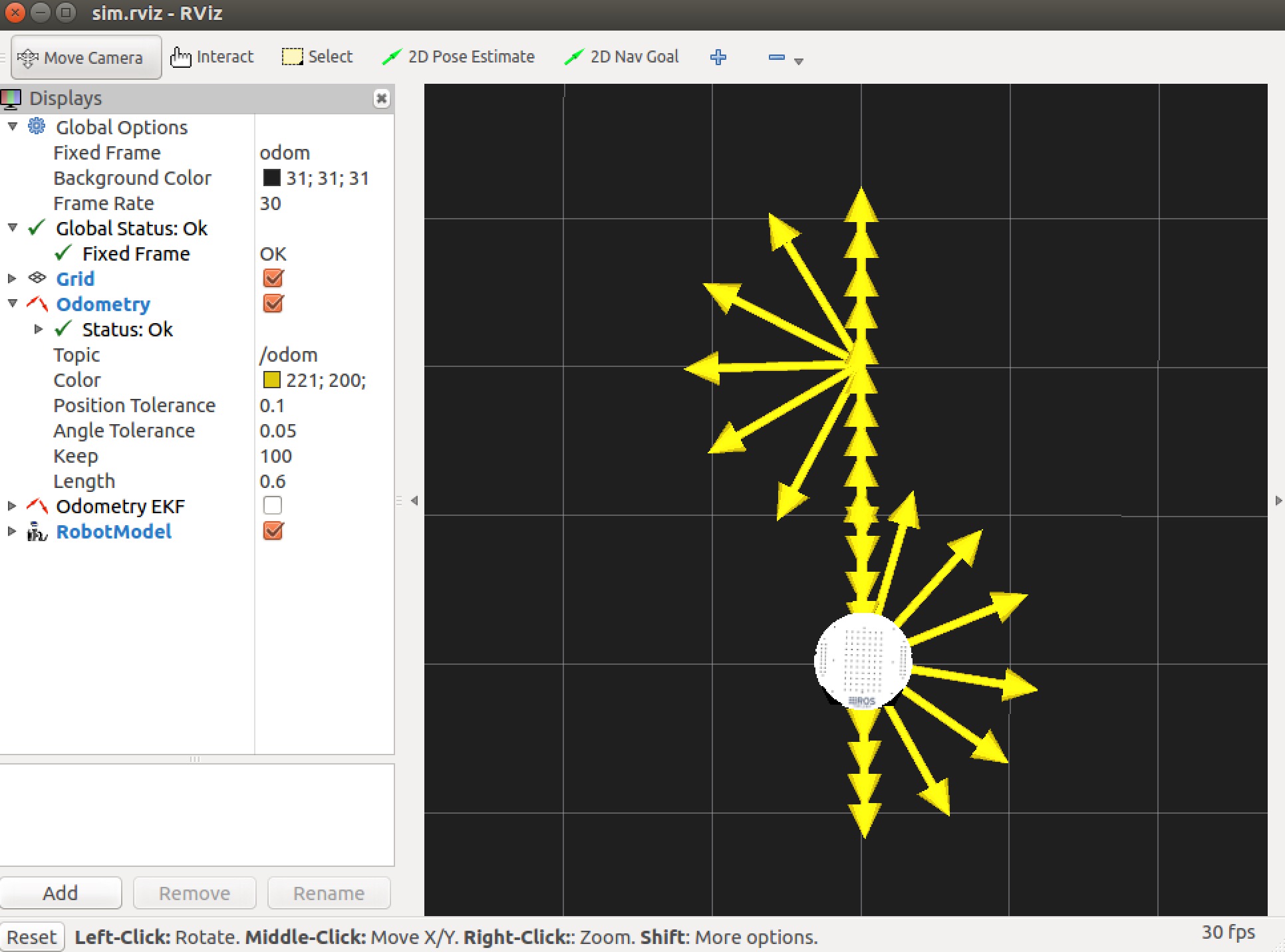概述
ROS 位置反馈控制机器人
上一篇中我们学习了如何发布Twist消息控制机器人运动特定距离,但是上一篇用的是基于延时的开环控制,并没有引入反馈,在实际情况中几乎不可能准确到达目标点。所以这一篇我们学习如何用位置反馈闭环控制机器人。
- 启动机器人
- 从终端发布Twist消息控制机器人
- 下一步
1.启动机器人
ROS中提供了了一个Odometry消息类型可以得到机器人的位置信息。先看一下该消息的具体内容
rosmsg show nav_msgs/Odometry
可以看出Odometry中包含pose:三轴位置信息,三轴欧拉角(用四元数表示),Twist:三轴线速度,三轴角速度。这两个消息中都包含了与测量不确定度有关的方差信息,可以很方便地用来卡尔曼滤波。
先启动机器人:
roslaunch rbx1_bringup fake_turtlebot.launchrosrun rviz rviz -d `rospack find rbx1_nav`/sim.rviz然后启动odom_out_and_back.py:
rosrun rbx1_nav odom_out_and_back.py结果如下:

和开环效果是一样的,因为这里是模拟的理想情况。
2.源码分析
import rospy
from geometry_msgs.msg import Twist, Point, Quaternion
import tf
from rbx1_nav.transform_utils import quat_to_angle, normalize_angle
from math import radians, copysign, sqrt, pow, pi
class OutAndBack():
def __init__(self):
# Give the node a name
rospy.init_node('out_and_back', anonymous=False)
# Set rospy to execute a shutdown function when exiting
rospy.on_shutdown(self.shutdown)
# Publisher to control the robot's speed
self.cmd_vel = rospy.Publisher('/cmd_vel', Twist, queue_size=5)
# How fast will we update the robot's movement?
rate = 20
# Set the equivalent ROS rate variable
r = rospy.Rate(rate)
# Set the forward linear speed to 0.2 meters per second
linear_speed = 0.2
# Set the travel distance in meters
goal_distance = 1.0
# Set the rotation speed in radians per second
angular_speed = 1.0
# Set the angular tolerance in degrees converted to radians
angular_tolerance = radians(2.5)
# Set the rotation angle to Pi radians (180 degrees)
goal_angle = pi
# Initialize the tf listener
self.tf_listener = tf.TransformListener()
# Give tf some time to fill its buffer
rospy.sleep(2)
# Set the odom frame
self.odom_frame = '/odom'
# Find out if the robot uses /base_link or /base_footprint
try:
self.tf_listener.waitForTransform(self.odom_frame, '/base_footprint', rospy.Time(), rospy.Duration(1.0))
self.base_frame = '/base_footprint'
except (tf.Exception, tf.ConnectivityException, tf.LookupException):
try:
self.tf_listener.waitForTransform(self.odom_frame, '/base_link', rospy.Time(), rospy.Duration(1.0))
self.base_frame = '/base_link'
except (tf.Exception, tf.ConnectivityException, tf.LookupException):
rospy.loginfo("Cannot find transform between /odom and /base_link or /base_footprint")
rospy.signal_shutdown("tf Exception")
# Initialize the position variable as a Point type
position = Point()
# Loop once for each leg of the trip
for i in range(2):
# Initialize the movement command
move_cmd = Twist()
# Set the movement command to forward motion
move_cmd.linear.x = linear_speed
# Get the starting position values
(position, rotation) = self.get_odom()
x_start = position.x
y_start = position.y
# Keep track of the distance traveled
distance = 0
# Enter the loop to move along a side
while distance < goal_distance and not rospy.is_shutdown():
# Publish the Twist message and sleep 1 cycle
self.cmd_vel.publish(move_cmd)
r.sleep()
# Get the current position
(position, rotation) = self.get_odom()
# Compute the Euclidean distance from the start
distance = sqrt(pow((position.x - x_start), 2) +
pow((position.y - y_start), 2))
# Stop the robot before the rotation
move_cmd = Twist()
self.cmd_vel.publish(move_cmd)
rospy.sleep(1)
# Set the movement command to a rotation
move_cmd.angular.z = angular_speed
# Track the last angle measured
last_angle = rotation
# Track how far we have turned
turn_angle = 0
while abs(turn_angle + angular_tolerance) < abs(goal_angle) and not rospy.is_shutdown():
# Publish the Twist message and sleep 1 cycle
self.cmd_vel.publish(move_cmd)
r.sleep()
# Get the current rotation
(position, rotation) = self.get_odom()
# Compute the amount of rotation since the last loop
delta_angle = normalize_angle(rotation - last_angle)
# Add to the running total
turn_angle += delta_angle
last_angle = rotation
# Stop the robot before the next leg
move_cmd = Twist()
self.cmd_vel.publish(move_cmd)
rospy.sleep(1)
# Stop the robot for good
self.cmd_vel.publish(Twist())
def get_odom(self):
# Get the current transform between the odom and base frames
try:
(trans, rot) = self.tf_listener.lookupTransform(self.odom_frame, self.base_frame, rospy.Time(0))
except (tf.Exception, tf.ConnectivityException, tf.LookupException):
rospy.loginfo("TF Exception")
return
return (Point(*trans), quat_to_angle(Quaternion(*rot)))
def shutdown(self):
# Always stop the robot when shutting down the node.
rospy.loginfo("Stopping the robot...")
self.cmd_vel.publish(Twist())
rospy.sleep(1)
if __name__ == '__main__':
try:
OutAndBack()
except:
rospy.loginfo("Out-and-Back node terminated.")3.下一步
最后
以上就是英勇电话为你收集整理的ROS 位置反馈控制机器人的全部内容,希望文章能够帮你解决ROS 位置反馈控制机器人所遇到的程序开发问题。
如果觉得靠谱客网站的内容还不错,欢迎将靠谱客网站推荐给程序员好友。
本图文内容来源于网友提供,作为学习参考使用,或来自网络收集整理,版权属于原作者所有。







![[ROS]机器人操作系统介绍ROS介绍为什么要学ROS怎样学ROS](/uploads/reation/bcimg4.png)
发表评论 取消回复